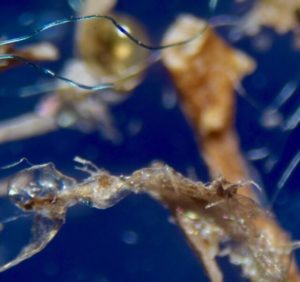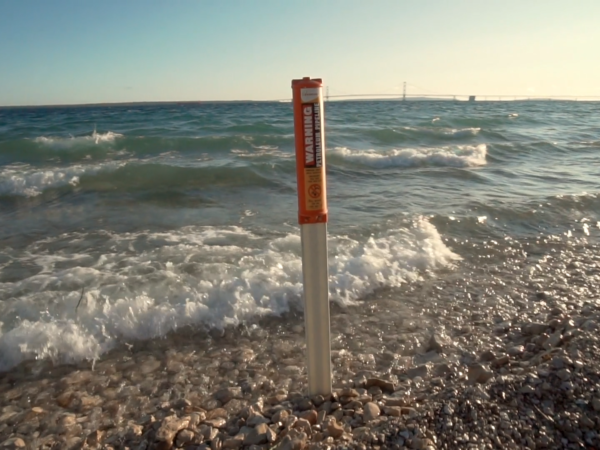
Editor’s note: A lot of commenters have asked how to get a filter. The one used in the specific study is from Filtrol. There’s also a Canadian company, Environmental Enhancements, that makes similar filters. Email us at greatlakesnow (at) dptv.org if you know of more.
While Great Lakes’ communities have organized plastic pollution cleanups and recycling campaigns for decades now, the threat of microplastics water pollution is only starting to sink in.
According to the United States Geological Survey, there are 112,000 particles of microplastics per square mile of Great Lakes water.
One potential solution for keeping microplastics out of the lakes is washing machine filters, and it’s a solution that researchers in Ontario will be exploring over the next couple of years.

Washing machine filter, Photo Georgian Bay Forever
Next month, 100 households in Parry Sound, Ontario, on the shores of Lake Huron’s Georgian Bay, will install special filters on their washing machines. The filters – roughly twice the size of a standard water bottle – are designed to remove plastic microfibers from the machines’ waste water.
It’s part of a joint research project by the University of Toronto and local environmental group Georgian Bay Forever to reduce the number of tiny plastic threads released into the bay.
By one estimate, each cycle of a washing machine releases more than 700,000 microscopic plastic fibres into the environment. These fibers come from synthetic fabrics such as nylon and fleece clothing. Waste water treatment plants aren’t designed to filter them, and so the fibers make their way directly into local waterways, including the Great Lakes – a source of drinking water for more than 30 million people.
“Although washing our clothes in washing machines is just one source of microfibers to the environment, we know that it’s a significant source,” said Chelsea Rochman, a microplastics researcher at the University of Toronto. “In the city of Toronto, we estimate as many as 23 to 36 trillion microfibers may be emitted to Lake Ontario watersheds each year.”

Blown up picture of microfibers, Photo by Lisa Erdle
Plastics are made from many different chemicals, and scientists still don’t know how many of these ingredients might affect human health. Still, some ingredients such as polyvinyl chloride are known carcinogens, while phthalates are endocrine disruptors. Endocrine disruptors are chemicals that mimic hormones, triggering unexpected changes in our cells’ growth and development. These chemicals can fake out our bodies’ normal signals and lead to disease.
Plastics can also act like a chemical sponge, soaking up other pollutants in the environment. For example, researchers have found pesticides and other toxic compounds in plastics floating in water, and those plastics have in turn been found in the bellies of fish in the Great Lakes.
A study released this month found that the average American consumes and inhales more than 74,000 particles of microplastics per year. People who drink only bottled water could consume an additional 90,000 microplastics annually compared to an additional 4,000 for those who drink only tap water.
Real world filter test
The washing machine filters, which retail for about $150, are made by a company in Minnesota and remove roughly 90 per cent of microfibers, said Lisa Erdle, a researcher in Rochman’s lab who is leading the Parry Sound project.
“Rigorous testing in our lab shows they work in a controlled setting,” Erdle said. “We’re curious to see if they work in real people’s homes. Do they use it properly? How often do they change the filter?”

Filter capture from one month of one family’s laundry. Photo by Georgian Bay Forever
Erdle and her team will test water at the town’s waste water treatment plant before and after the filters are installed. The study will run for two years and results will be publicly available. Erdle suspects that because Parry Sound has a population of just 6,400, the decrease in microfiber concentrations will be noticeable.
While the ideal solution would be to not manufacture synthetic clothing in the first place, Erdle said, burying washing machine lint in the landfill at least keeps it out of our waterways.
She and Georgian Bay Forever project coordinator Cassie Weston hope their findings will create greater awareness and eventually lead to the mandatory use of washing machine filters.
“Before I started this job, I had no idea of how much plastic from clothes was floating around,” Weston said. “And neither did anyone I talked to.”
Like Weston, Parry Sound resident Gail Campbell only recently learned about the issue of plastic microfibers and is upset to think she might be contributing to the problem. She was among the first to volunteer to have a filter installed on her washing machine.
“I’m trying to cut down on plastics I can see and touch. But there are these little microplastics we can’t see that are everywhere,” she says. “How much am I putting back into the environment when I wash my fleece?”
6 Comments
-
What is the name of the filter? Seems like that should be part of the article
-
Where can I get one??
Name of the company in MN, please! -
The filter looks like it is made of plastic. Why contribute to more plastic waste?!?
-
Where can we get them? That is a small amount of money to help protect the enviorment!
-
any results from this study yet?
thanks in advance! -
http://www.filtrol.net – this is the company.




